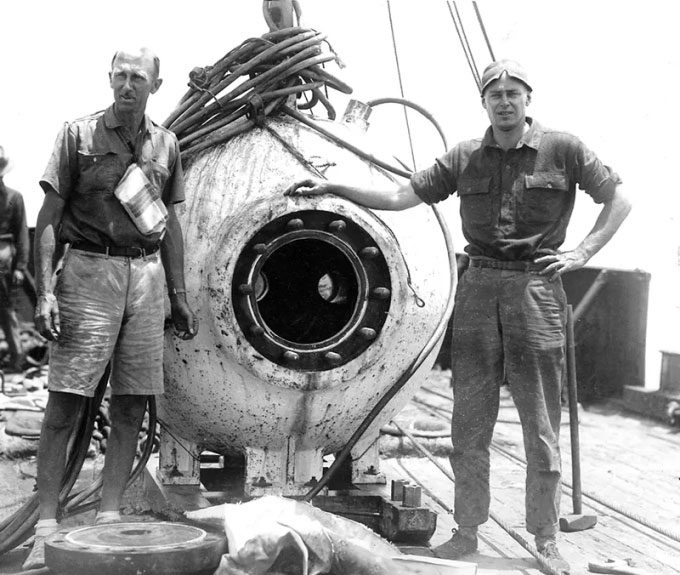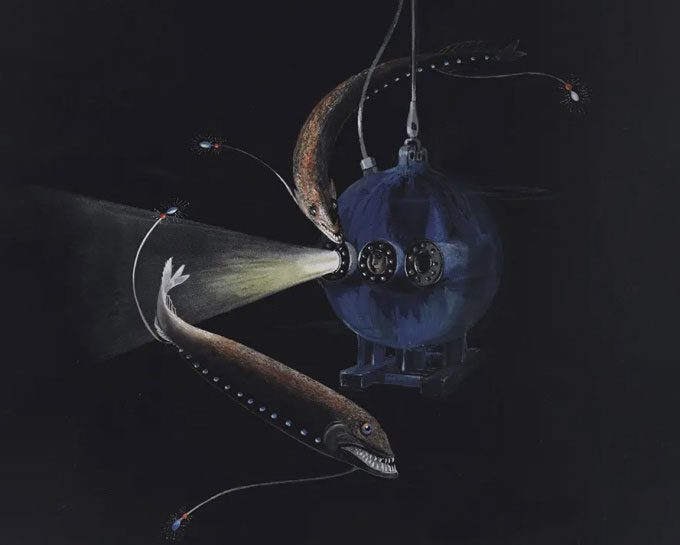The Bathysphere: A Deep-Sea Submersible that Revolutionized Marine Observation
Nearly 100 years ago, the Bathysphere was created to fulfill scientists’ dream of directly observing deep-sea marine life. In 1925, American naturalist William Beebe proposed the idea of a submersible that could take humans deep into the ocean. By the late 1920s, the maximum depth safely achievable by humans using diving helmets was only a few hundred feet (1 foot is approximately 0.3 meters). At that time, submarines could only reach depths of up to 117 meters but lacked windows, rendering them useless for Beebe’s goal of observing deep-sea creatures. The greatest depth reached by a human at that time was 160 meters using a diving suit, but these suits made movement and observation extremely difficult.

William Beebe (left) and Otis Barton (right) with the Bathysphere. (Photo: Rare Historical Photos).
Beebe hoped to create a vessel that could dive much deeper than the records of that era while allowing him to clearly observe and document the wildlife of the deep ocean. Eventually, Beebe partnered with engineer Otis Barton, who aspired to become a deep-sea explorer. Barton designed a spherical vessel, as the spherical shape could withstand immense pressure.
The sphere featured three thick quartz glass windows, each 76mm thick, which was the most durable transparent material available at the time. A heavy 180kg door would seal shut before the submersible descended. Oxygen was supplied from high-pressure tanks inside the sphere, while devices containing soda lime and calcium chloride were affixed to the inner walls to absorb moisture and exhaled CO2. A light was mounted at one of the windows to illuminate the creatures outside. The vessel was also equipped with a telephone system to facilitate communication with the surface.
Beebe named the vessel Bathysphere after the genus Bathytroctes, a group of fish that live in the deep sea. To operate, the vessel was lowered into the water using a cable.
After the first version of the sphere was cast in June 1929, experts deemed it too heavy to be raised and lowered safely using a winch. This led Barton to melt down the sphere and recast it.
The final design became lighter, featuring a hollow steel sphere 25mm thick with a diameter of 1.45 meters. On land, its weight was 2.25 tons. The 910-meter steel cable weighed 1.35 tons. The vessel was also equipped with a camera, thermometer, and depth gauge.
On June 11, 1930, the Bathysphere descended to a depth of 400 meters, later achieving 900 meters in 1934. Through these dives, the vessel demonstrated its capabilities but also revealed its weaknesses. It was challenging to operate and posed significant risks. A broken cable could result in death for the occupants.

Simulation of the Bathysphere operating in the deep sea. (Photo: Else Bostelmann).
Beebe continued his research throughout the 1930s. However, he eventually felt that he had observed enough with the Bathysphere, and the cost of further dives outweighed the knowledge gained. When World War II broke out, Bermuda was converted into a military base, significantly destroying the natural environment and making thorough research in that area impractical.
After Beebe ceased using the Bathysphere, it remained the property of the New York Zoological Society. The vessel was stored until it was displayed at the 1939 New York World’s Fair. By 1957, it was showcased at the New York Aquarium.
Although the technology of the Bathysphere gradually became obsolete and was replaced by more advanced submersibles, it enabled researchers for the first time to observe deep-sea creatures in their natural habitats, setting a precedent for many future researchers. Therefore, the contributions of the Bathysphere to oceanography and deep-sea exploration remain highly significant.


















































